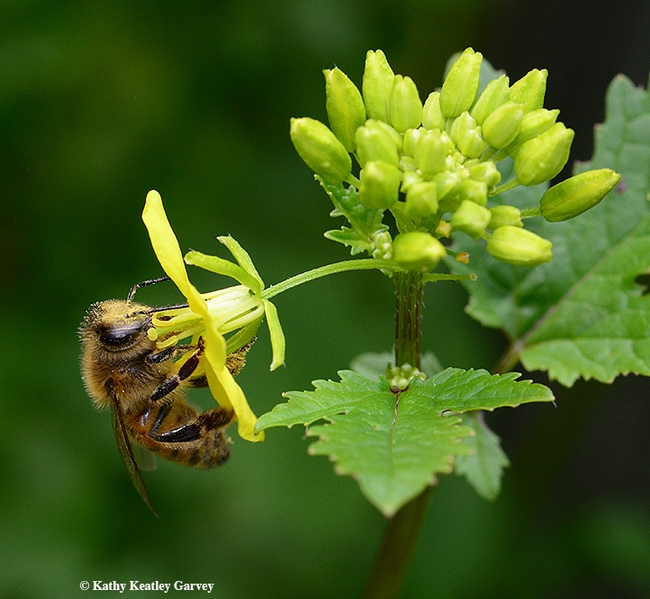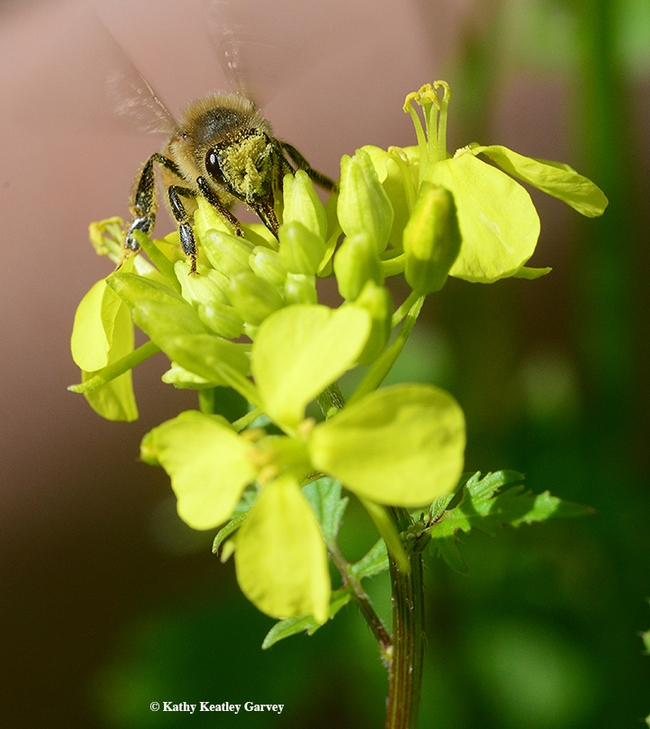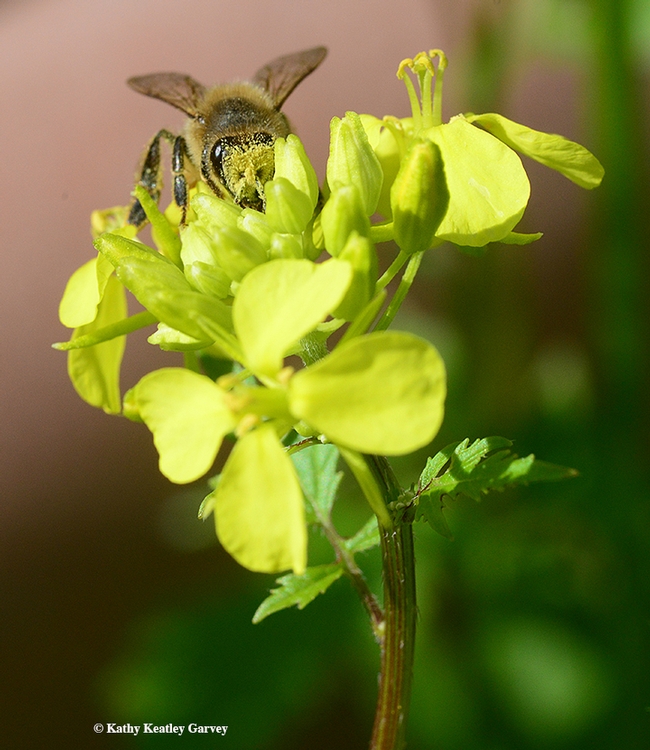- Author: Kathy Keatley Garvey
All hail the honey bee!
It's an immigrant, like almost all of us, except for the Native Americans.
European colonists brought the honey bee (Apis mellifera) to what is now the United States in 1622. Specifically, they arrived at the Jamestown colony (Virginia). The Native Americans called the honey bee "the white man's fly." California had no honey bees until 1853 when a beekeeper brought his colonies to the San Jose area.
If you're like me, you can watch honey bees for hours.
Pull up a chair near a bee-buzzing event, watch them forage, and photograph them.
Pardon me, Ms. Bee, is that mustard on your head?
Yes, indeed.
It's bee-utiful to see golden pollen dusted all over their bodies from head to thorax to abdomen. Then there are those immense balls of golden pollen that weight them down and hinder their flight.
I took these images with a Nikon D500 with a macro lens, 200mm. The settings: 800 ISO, f-stop 8, and shutter speed, 1/2500.
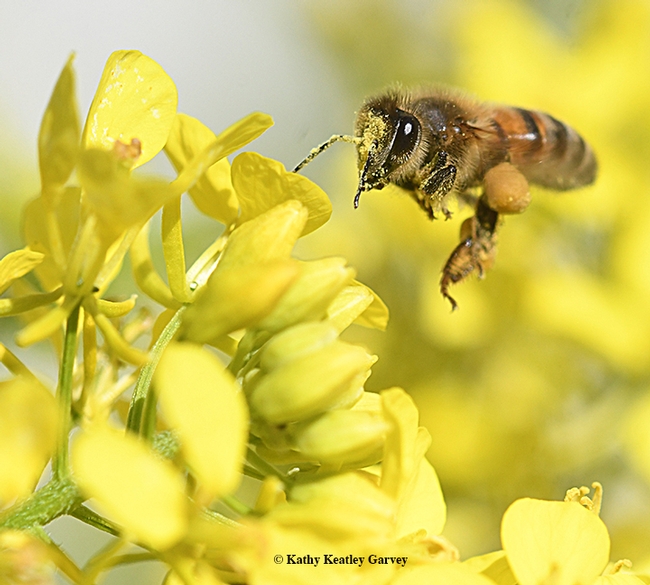
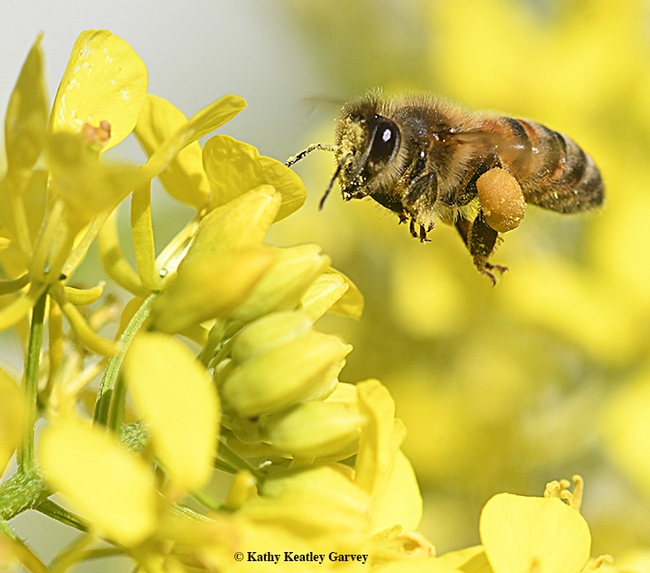
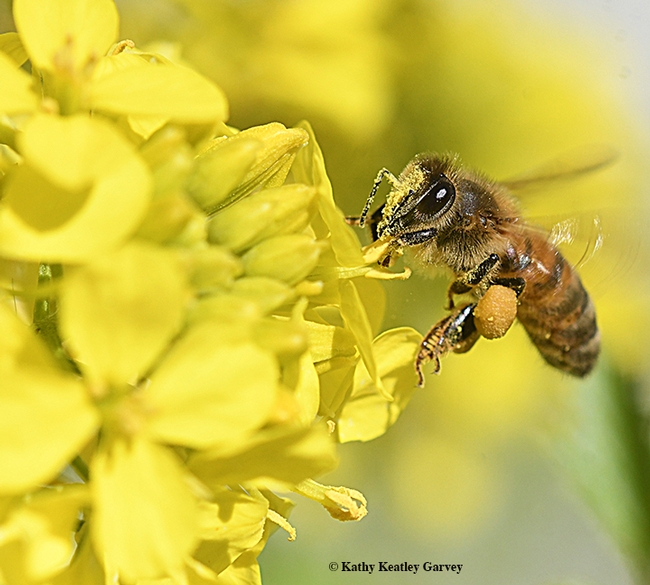
- Author: Kathy Keatley Garvey
"Eat your greens," they say.
Okay, we don't need any encouragement, but apparently many other folks need a push, a poke or a prod to eat cole crops, including cabbage, cauliflower, Brussels sprouts, broccoli, mustard, kale and kohlrabi.
Well, cabbage aphids need no encouragement. We spotted some dusty blue-gray aphids, Brevicoryne brassicae, slurping the very life blood out of our mustard plants yesterday in Vacaville, Calif. That's what they do, and they do it well, thank you.
Frankly, we're so accustomed to seeing green and yellow aphids, that the blue-gray colors are sort of a treat. Sort of. But they are a pest. These European natives can and do cause significant yield losses to cole crops (mustard family, Brassicaceae).
And they are not social distancing.
The UC Statewide Integrated Pest Management Program (UC IPM) says: "They commonly occur in dense colonies, often covered with waxy droplets. They prefer to feed on the youngest leaves and flowering parts and are often found deep within the heads of cabbages or Brussels sprouts. The aphid has a simple life cycle with adult females giving birth to live offspring throughout the year in most parts of California. Both winged and wingless adults occur; the winged adults have a black thorax and lack the waxy coating. The aphid does not infest noncruciferous crops but can survive on related weed species when cole crops are not in the field."
UC IPM goes on to say that "Important natural enemies include lady beetles, syrphid fly larvae, fungal diseases, and the parasitic wasp, Diaeretiella rapae."
Nary a lady beetle (aka ladybug) in sight--but a syrphid (aka flower fly or hover fly) just landed.
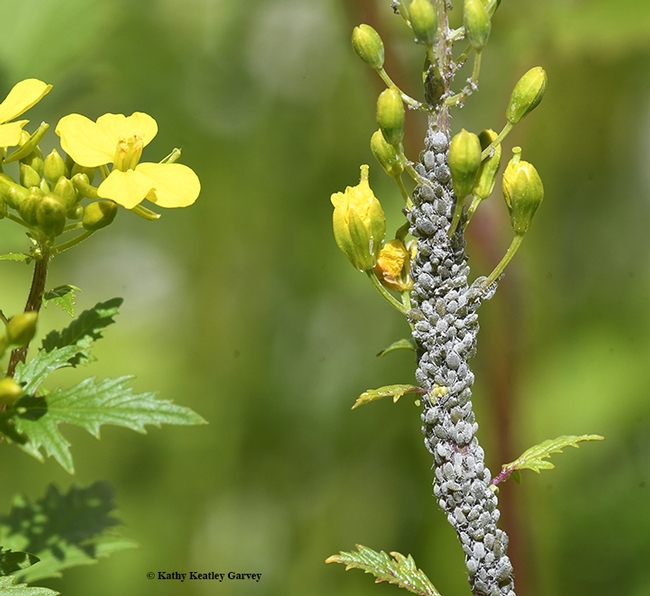
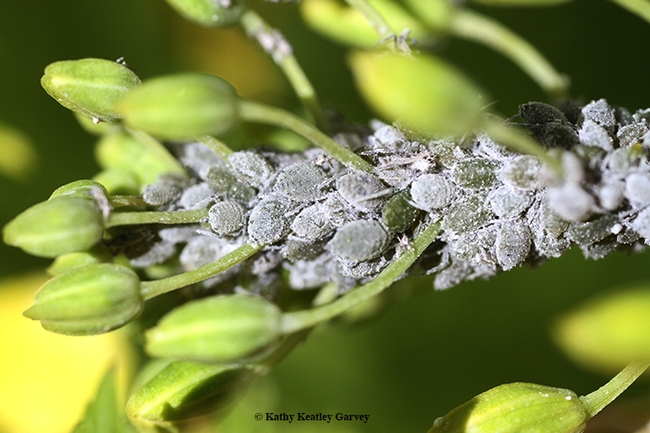
- Author: Kathy Keatley Garvey
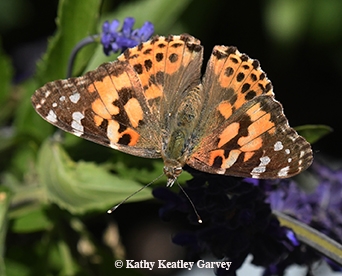
The honey bee and the Painted Lady.
Apis mellifera and Vanessa cardui.
They both wanted to sip that sweet nectar from a mustard blossom.
The Painted Lady was there first. Sometimes it's "first come, first served" and sometimes it's "I'll have what she's having."
The persistent bee managed to forage a bit around the blossom, but the butterfly, just as persistent, stayed put.
Finally, the bee buzzed over the butterfly, nearly touching it, as it headed for new territory.
Meanwhile, the cardui migration continues, from California through the Pacific Northwest. Millions have already moved through the Davis/Sacramento area on their way up north.
"It's Week 11, Day 81," says butterfly guru Art Shapiro, UC Davis distinguished professor of evolution and ecology. "It's almost over (through this area)."
An article published May 19 in the Idaho Statesman, Boise, announced that "Hundreds of Butterflies Flitted Through Boise This Weekend."
"This weekend, Boiseans found themselves in the middle of a massive migration as hundreds of orange-and-brown butterflies known as painted ladies winged their way through the area," wrote reporter Nicole Blanchard. "Dozens of people on social media shared accounts of seeing the butterflies flying overhead en masse or stopping to snack on spring blooms. Many of the painted lady butterflies, which are often mistaken for monarchs because of their orange coloring, were spotted in the North End and Foothills on Saturday."
One Boise resident related on Twitter that she saw 56 flying northwest through her yard in a period of two minutes.
Want to learn more about Painted Ladies and other butterflies? Check out Art Shapiro's website. He's been monitoring the butterfly populations of Central California since 1972.
On Vanessa carduii: The mass migration begins near the U.S.-Mexico border, Shapiro says. They breed "in the desert after the winter rains generate a crop of annual Malvaceous, Boraginaceous and Asteraceous hosts. The resulting butterflies migrate north. In good years (lots of desert rain) they may do so by billions, interfering with traffic and attracting the attention of the media. 2005 was one of the biggest Painted Lady years in history--perhaps the biggest," he says. This year was also a very good year.
"They do not stop to feed or have sex until they have burned up their reserves, carried over from the caterpillar stage," according to Shapiro. "They fly in a straight line from SE to NW, like 'bats out of Hell,' and go over obstacles rather than trying to go around them. (On certain days there may be concerted local movements in the wrong direction. We do not understand these.) Painted Ladies tend to fly parallel to the Sierra Nevada, not across it. They enter the Central Valley through the Inyo-Kern lowland or by crossing the Transverse Ranges. They can apparently make it from Bishop to Davis in three days. In some years the migration is heavier in the Great Basin and on the East slope of the Sierra than farther west. The Painted Lady moves northward in a generational wave as the season progresses. Frequently it disappears altogether from the lowlands in summer. Beginning in August the movement reverses and butterflies head south toward the desert wintering grounds. The southward migration is a more protracted affair, with plenty of adult feeding and some breeding en route. Numbers tend to be highest east of the crest, on Rabbitbrush blossoms in October."
It's been a very good year for these orange-black butterflies, which began arriving in the Davis/Sacramento area on March 17. Just don't confuse them with Monarchs! Shapiro can't begin to count the calls of folks telling him that the Monarch is no longer in trouble; that "there are millions of them!"
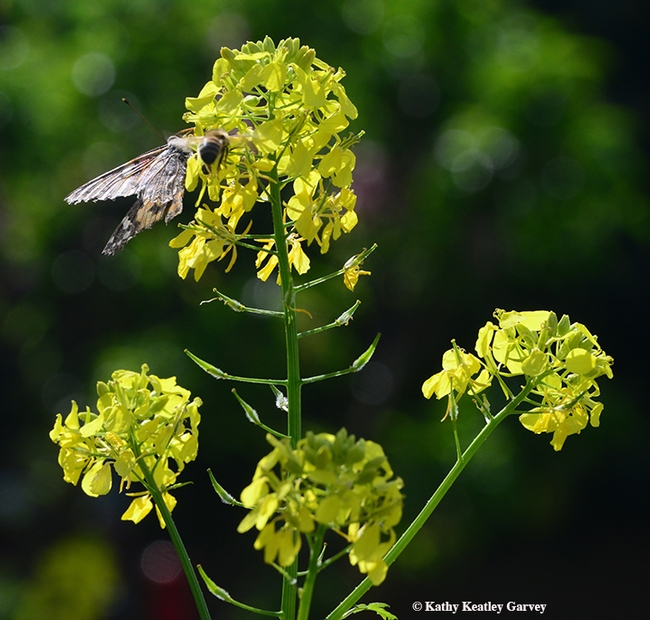
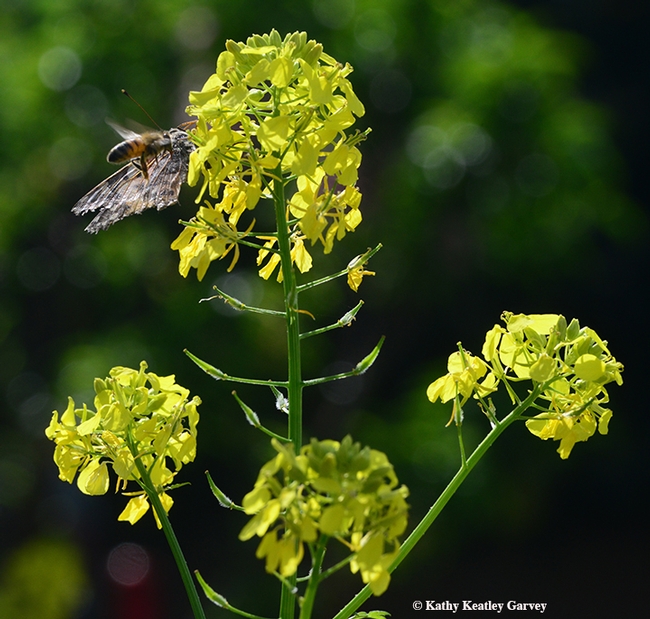
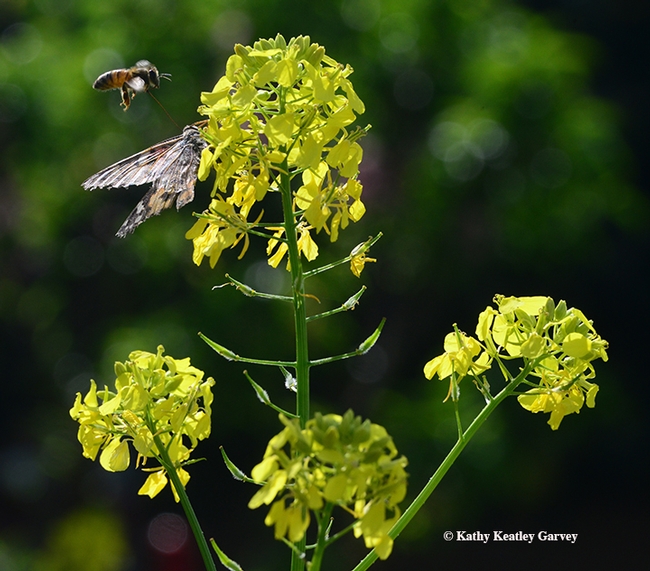
- Author: Kathy Keatley Garvey
Yes, I'll have some mustard, please.
Yes, both the pollen and the nectar, thank you.
We watched a honey bee buzz into our little mustard patch, her proboscis (tongue) extended, and pollen weighting her down. If she were at the airport, someone would have volunteered to carry her bags.
But there she was, determined to bring back both pollen and nectar to her colony. It's nature's equivalent of gold. It's spring and time for the colony build-up.
In peak season, the queen bee lays 1500 to 2000 eggs a day. Everyone has a job to do, and if you're a bee scientist or a beekeeper, you'll see them all: nurse maids, nannies, royal attendants, builders, architects, foragers, dancers, honey tenders, pollen packers, propolis or "glue" specialists, air conditioning and heating technicians, guards, and undertakers.
What's thrilling this time of year, though, are the worker bees bringing home the mustard.
Want to learn more about bees? Be sure to stop by Briggs Hall, off Kleiber Hall Drive, on Saturday, April 13 during the campuswide 105th annual UC Davis Picnic Day. You'll see a bee observation hive, as well as smokers, hive tools and veils, all part of the UC Davis Department of Entomology and Nematology displays. You can talk to the bee scientists. And you can sample many different varietals of honey.
Briggs Hall also will feature cockroach races, maggot art, t-shirt sales, face-painting, aquatic insects, forensic entomology, Integrated Pest Management Program display, fly-tying and much more. It's free and family friendly.
And over at the Bohart Museum of Entomology, located in Room 1124 of the Academic Surge Building, more entomological excitements await. It's the home of nearly eight million insect specimens, plus a gift shop and a live "petting zoo" of Madagascar hissing cockroaches, stick insects (walking sticks), tarantulas and praying mantids. Stay tuned!
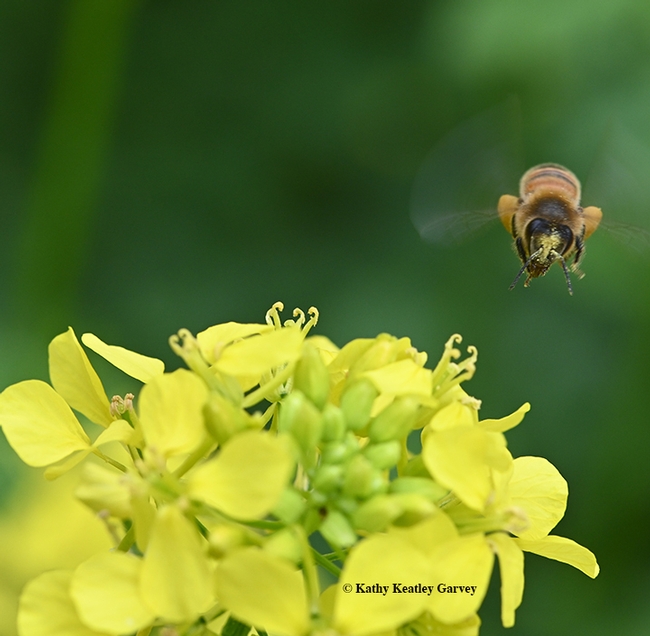
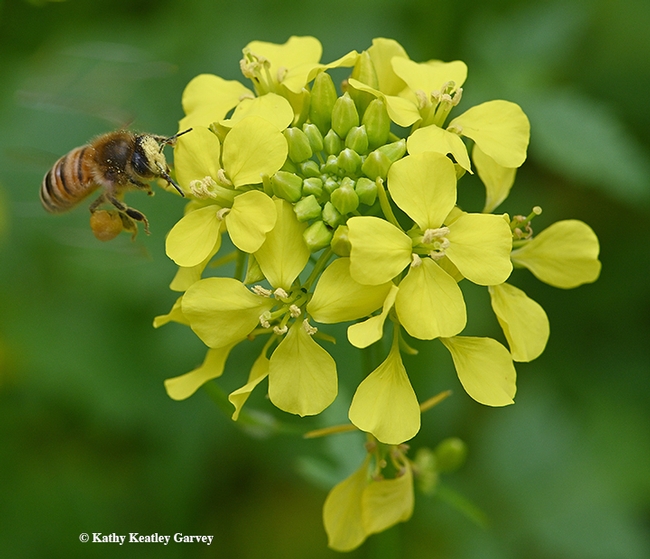
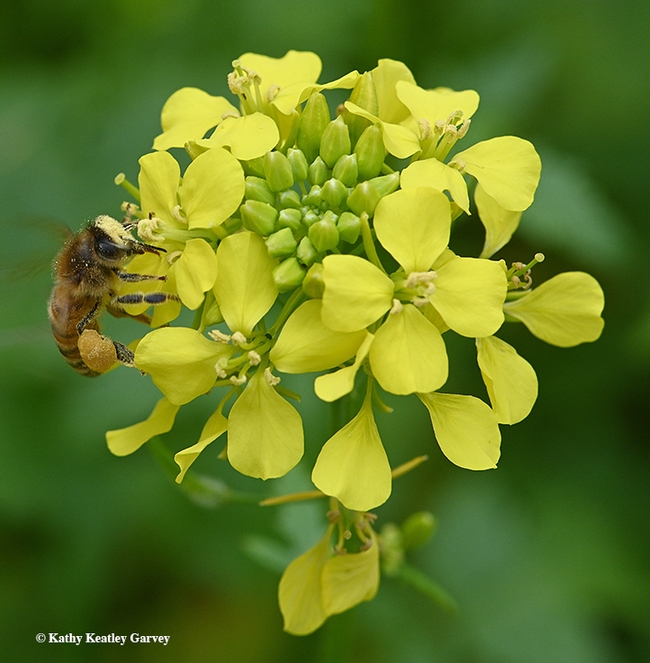
- Author: Kathy Keatley Garvey
The phrase "can't cut the mustard" (not able to handle the job) doesn't apply to honey bees. It's spring and honey bees are emerging en force from their hives to collect nectar and pollen to feed their colonies.
The fields are awash with mustard.
By the way, O. Henry, in his collection of short stories, The Heart of the West, was apparently the first known person to use the phrase, "Cut the mustard." He wrote: "I looked around and found a proposition that exactly cut the mustard."
Today we hear the more negative version, "can't cut the mustard."
Meanwhile, it's a joy to see a bee swathed in gold dust from the mustard. In doing so, our bee is akin to the kid with a milk mustache. Life is good!
"The importance of pollen to the health and vigor of the honey bee colony cannot be overstated," UC Davis emeritus professor and retired bee wrangler Norman Gary writes in the newly published second edition of his book, The Honey Bee Hobbyist: The Care and Keeping of Bees. "Bees need a balanced diet. Honey satisfies the bees' carbohydrate requirements, while all of the other nutrients--minerals, proteins, vitamins and fatty substances--are derived from pollen. Nurse bees consume large amounts of pollen, converting it into nutritious secretions that are fed to developing larvae. During an entire year a typical bee colony gathers and consumes around 71 pounds (35 kg) of pollen."
The next time you see honey bees collecting pollen, think of a colony gathering 71 pounds of pollen a year!
